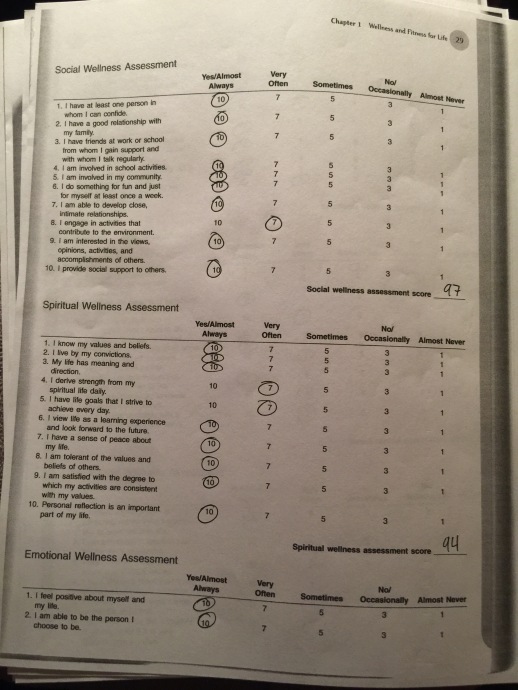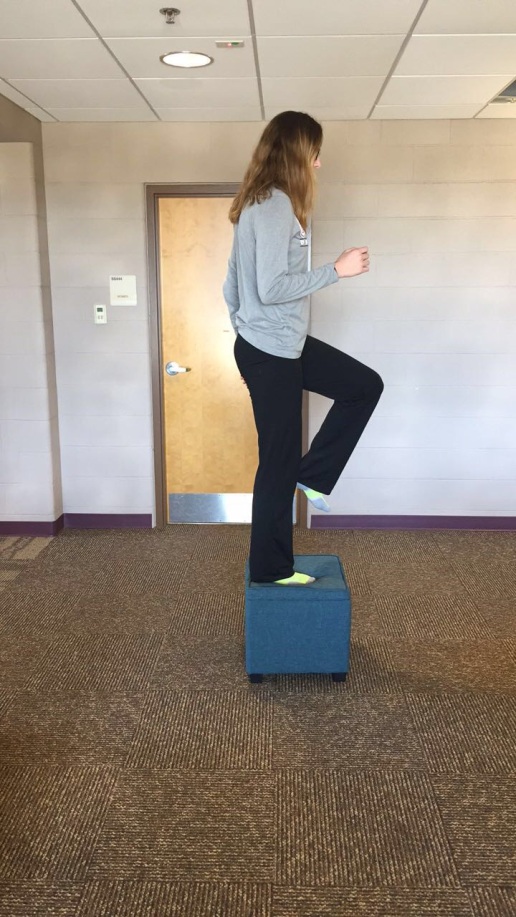Stretching the Limits!
Wellness Assessment #1: Sling Test (Assessment Activity 5-3)

Purpose: The “sling test” is to asses the length and flexibility of the extensor muscles (sling muscles) in my back.
Directions: Lay on your back on the floor and bend both knees. Pull your choice of leg to your chest tightly grasping knee (you will eventually switch so it doesn’t matter which one you choose first). Straighten out opposite leg and push it towards the floor while still holding your other leg tightly against your chest. Have someone measure distance between floor and the back of your leg with a ruler. Lastly, change legs and repeat steps listed above.
Personal Response: I completed this one time for each leg, but I think the more warmed up my muscles would get, the further I could get.
Left Leg: 1.25 in. from ground
Right Leg: 2 in. from ground
Concluding Statements: This exercise was fairly easy to carry out. It didn’t need many materials in order to properly complete the test. I enjoyed this test because I was curious to see how close I could get my leg to the floor. However, I had nothing to really compare my results with except that of my other leg. This isn’t the best test to base flexibility on because there could be many reasons why your leg gets closer to the floor than that of another person doing the same test (ie. taller, heavier legs). It is fine to test and see where you are at personally, but for comparing and contrasting, it might not be the most accurate.
Trunks Up
Wellness Assessment #2: Trunk Extension (Assessment Activity 5-4)

Purpose: Measure the flexibility of the abdominal and hip flexor muscles.
Directions: Lay face down on floor, face down and have someone sit on your legs. Put your hands folded on your lower back, inhale, and then lift your body as high as you can off the floor and hold so someone can come measure the distance between the floor and your chin with a ruler. Repeat this process 2 more times, for a total of three times.
Personal Response: I did the three trials one after another and improved my distance each time.
Trial 1: 9 in.
Trial 2: 10.25 in.
Trial 3: 11.5 in.
Concluding Paragraph: This test was fairly simple to do. You have to make sure you have enough people who are willing to help you measure and hold your legs to carry out the test properly. I feel that it isn’t that practical and that there aren’t many instances you need to know how flexible your hip flexors and abdomen are. However, it felt good to stretch out, and having the three different trials made me want to improve my distance I got up off of the floor each time. Overall I liked this test and it was easy to conduct, carry out and record the data.
I Sat Up!!
Wellness Assessment #3: Canadian Trunk Strength Test (Assessment Activity 4-3)

Purpose: This test measures abdominal muscular endurance.
Directions: Lay on the floor, face up, knees bent to 90 degrees with arms extended. Place a piece of tape at your fingertips on each side and then place 2 more pieces of tape 8 cm in front of the original 2 pieces on either side once again. Curl up from the first set of pieces to the second set of pieces of tape and back to resting position and that counts as one curl-up. It must be controlled and continuous (i.e. 20 curl-ups/min). Do as many as you can making sure to stay on cadence (with the maximum being 75).
Personal Response: I did 75 curl-ups, which puts me in the excellent category because to be considered excellent for my age group, I had to complete 50, and since I did 75, I exceeded the expectation.
Concluding Statements: This test was simple to carry out. You only need tape, ruler and your body to do this test. This is a practical test and I know that many schools around the country do these tests that are nationally mandated, so these are practical. I enjoyed this test and the day after my abs were sore so I know that it was very good for my body to do this exercise. This was pretty simple, however towards the end of the end of the 75 reps, it began to get a little more challenging.
Do you determine your health??
Wellness Assessment #4: Health Locus of Control (Assessment Activity 1-2)

Purpose: This short quiz will show you what your locus of control is and how it can possibly affect your health. There are 3 sub scales included in this quiz: (1) The Internal Health Locus of Control Scale (I), amount of control of your health, (2) The Powerful Others Health Locus of Control Scale (P), amount of power higher powers have in controlling your health, and (3) The Chance Health Locus of Control Scale (C), how you feel your health is determined (luck, fate, or chance).
Directions: For all of the questions asked, select number 1-5 that shows what you feel towards the question that is asked (5-strongly agree, 4- agree, 3- agree, 2- disagree, 1- strongly disagree).

Personal Response: For analyzing this test, you must add all of the numbers that you put down for each category so you are able to determine your score for each of the category so you can rank them and find where your beliefs have you stand. For the I category, I had a score of 16, which put me in the range of moderate on the scoring scale, meaning I have moderate belief that my health is due to powerful others. For the category P, I had a score of 16 again which tells me the same thing as the I category did. For the C category, I had a score of 14, which put me low on the sub-scale which means I don’t believe I control my own health for this particular category.
Concluding Statements: This was an easy test to carry out because you just had to think about what you believe and transfer it to a scale of 1-5. It was a fast test that didn’t take long to carry out. However, I feel like this isn’t a very practical test. This wouldn’t be the first way I would suggest to test an individual about how much they feel they control their own health. I feel that what you do on a daily basis will affect your general health, especially if you develop bad habits (i.e. smoking, abusive drinking, overeating, not exercising). Also if you don’t take care of your body you will get sick a lot and not recover fast, especially if you don’t have a strong immune system set up, however sometimes sickness is inevitable (i.e. common cold, shared sicknesses, flu season, ect.) So in a way you do control your health but its hard to not get sick if everyone around you is sick or you don’t have a strong immune system built up.
GET MOVIN’!
Wellness Assessment #5: Road Rage and You (Assessment Activity 10-4)

Purpose: This is a test to determine how much road rage you have while driving.
Directions: Answer the questions provided on the paper to see how cautious of a drive you are. There are many statements down the side of the paper, then you check 1 of 4 options for each statement (rarely/never, sometimes, often, always).

Personal Response: When I was taking this quiz to see where I stood on road rage I found that I have a lot of good habits when I am on the road. Yes, I will get frustrated at the typical annoying driver on the road but I never get too heated behind the wheel of a car. Most of the statements listed on the paper I was able to check always for which shows that my driving habits are pretty good, but there was one in the sometimes category and four of the statements in the often category. The other seven statements were in the always category.
Concluding Statements: This test was very simple to conduct because it was just answering a few questions about your driving. I feel this test is very good to determine how well you follow the rules of the road and how mad or frustrated you are behind the wheel of a vehicle. This wold be a fairly simple test to distribute to see how others compare to you. I did the follow-up questions on the bottom of the sheet which made you think about some healthy ways to make sure you never get too angry while driving. Overall, I enjoyed taking this test and thinking about my driving habits and how they may affect others on the road at the same time as me.
Swell-ness!
Wellness Assessment #6: Lifestyle Assessment Inventory (Assessment Activity 1-1)
Purpose: This is a test to asses your overall wellness as an individual in the following ten categories: physical, alcohol and other drugs, nutrition, social, spiritual, emotional, stress controlled, intellectual, occupational, and environmental .
Directions: Read all of the questions below, using the scale answer each question based on where you fall relating to that statement. After each of the ten sections, add up the scores for that part and transfer it to the chart on the last page of the questionnaire. Once you have all of the totals entered in the chart, add up all of the scores and then divide the total number by 10 to determine your average wellness score.






Personal Response: I was in the 75-89 range which means I have good overall wellness. I thought I had excellent nutrition, however that was one of my lower categories along with dealing with stress, sometimes. Wellness is very important with the way you carry yourself.
Concluding Statements: This test was simple to conduct however it was a little lengthy. I feel this test is very good quality to determine how “well” you are because of the large amount and variety of questions for each of the categories. When I was taking this quiz to see where I stood on my overall wellness I found I have a lot of good habits. But, for some of the categories I noticed I have developed some bad habits I didn’t know were really negative to my wellness. I did the follow-up questions on the bottom of the sheet which made you think about some healthy ways to made you reflect on the parts of your overall wellness that could be improved and that are already good. Overall, I enjoyed taking this test and assessing my wellness.
Healthy Heart?
Wellness Assessment #7: What’s Your Heart Attack Risk? (Assessment Activity 2-1)
Purpose: This is a test to determine the probability of experiencing a heart attack in the next 10 years.
Directions: Answer a series of 12 questions. First, answer 1-9 and then do the addition or subtraction based on your answer to each question and write your subtotal at the bottom of the page. (Make sure you answer the left or right column only: men- left, women-right.) Next, go to items 10-12 and answer them. Then, add up your point for items 10-12 and then add up subtotal from section 1 (items 1-9) and subtotal from section 2 (items 10-12). Finally, interpret your results on the charts to the right hand side of the second page of the assessment.


Personal Response:
Subtotal section 1: 2
Subtotal section 2: 23.7
Total score: 25.7
A score of 25.7 put me in the first category for women. I have a <0.1% chance of having a heart attack this year. I have a <0.4% chance of having a heart attack in the next five years. I have a <1% chance of having a heart attack in the next ten years.
Concluding Statements: This test was easy to carry out because it was just answering a series of questions about your lifestyle. I feel this test is pretty accurate to determine your risk for a heart attack. This wold be a fairly simple test to distribute to see how prone others are to heart attacks. The results were easy to retrieve because the charts were very simple. Overall, I enjoyed answering this questionnaire because it made me feel safe, as far as heart attack risk.
Typical Fat Intake??… More than you would assume!
Wellness Assessment #8: Do You Have Fatty Habits? (Assessment Activity 6-4)
Purpose: This is a test to make you think about the kinds of fat you intake on a general basis.
Directions: For each of the food habit/type on the left side of the page select either the high-fat, medium-fat, or low-fat option that best suits your routines generally. Once you make all of the selections that best fit you, count how many from each of the categories (high, medium, low) and place them under each of columns in the blank. Then, for high-fat multiply the number you wrote in the blank by 2, for medium-fat multiply the number in the blank by 1, and for low-fat multiply the number in the blank by 0. Next, add up all of the numbers from each of the sections and get your total score. Finally, interpret your total score in the chart towards the bottom of the second page of the questionnaire.


Personal Response:
High-fat score: 8 x 2 = 16
Medium-fat score: 5 x 1 = 5
Low-fat score: 6 x 0 = 0
Total score: 21
I was in the 20-30 range in the chart which reads: FAT HABITS NEEDING IMPROVEMENT.
Concluding Statements: This test was very simple to conduct because it was thinking about your diet and answering a few questions about the regularity of it. I feel this test is not very accurate because it doesn’t take into account how many calories you are burning daily. People who are more active and weight lift need more fat intake to build muscle. This wold be a fairly simple test to distribute to see how others compare to you in fat intake. It made me feel not as healthy as I thought I was. However, some fat intake is necessary. Overall, I didn’t really enjoy taking this test because it made me feel like I don’t eat right and need to cut fat out of my diet to be healthy.
How Healthy Are You Actually?
Wellness Assessment #9: Assessing Your Health Behaviors (Assessment Activity 1-3)
Purpose: This is a test helps evaluate your health behaviors.
Directions: Make 2 lists, one being health-promoting behaviors and the other being health-inhibiting behaviors. Make sure to include behaviors from all of the aspects of wellness: mental, emotional, social, spiritual, and physical health.

Personal Response: I made a list of not only the behaviors I have but other promoting and inhibiting behaviors that other individuals might have or be struggling with. I found I personally have more health-promoting behaviors than that of the opposite side.
Concluding Statements: This assessment was very simple to conduct because it asks you to list 15 health-promoting and health-inhibiting behaviors. This is an effective way to really take a look at the good habits you have and the not so good habits. This wold be a simple test to distribute to see how either positive or negative another individuals life is. I did the follow-up question on the bottom of the page which made me think about something I would be willing to change right here, right now. That was a harder part, due to the fact that you were able to select something that you would like to see change. It really makes you think and want to change for the better. I enjoyed taking this test even though I didn’t just put statements that were true for me.
Bench Step
Wellness Assessment #10: The 3-Minute Bench Step Test (Assessment Activity 3-3)
Purpose: This is a test to determine your fitness category based on age and your heart rate after completing a 3-minute fitness exercise.
Directions: Step up and down with the beat of the metronome for 3 minutes. Once you have completed 3 minutes, sit down on the bench and take your pulse for one minute. The result you get from your heart rate is the number you take to the chart to determine what fitness category you fall under. (Make sure you don’t take pulse for 15 seconds and multiply by 4 because your pulse will begin to slow and that could effect your results).
Materials: Bench, timer, and metronome
*When reading results, make sure you are looking at the right age group and gender*

Personal Response: For women, 18-25 years, I was in the excellent category for this test which means my heart rate was between 72-83 for the minute after I stopped stepping for 3 minutes. My heart rate for the minute was 74 BMP.
Concluding Statements: This test was an easy test to carry out because I am in shape so it wasn’t hard at all. However, I had lifting the day before this which made my legs a little sore, but it was still very simple. This test is a good determiner for what fitness category you fall under because it is a physical test so the numbers don’t lie. This wold be a good test to compare your fitness level to others because there isn’t a reason the results should be faulty in any way. Overall, I liked this test and it was very easy to do.
